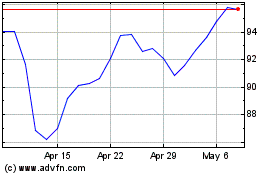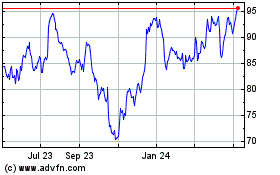The powerful rallies that have lifted stocks, crude oil and
emerging markets for the past three months have one important thing
in common—the falling dollar—and investors are growing anxious that
it could prove to be the weak link.
While the dollar is down 4.5% this year and near a one-year low
against a basket of currencies, other investments have surged. U.S.
crude prices are up 69% from their February lows. Gold was up 16.5%
in the first quarter, its best in three decades. And
emerging-market stocks, bonds and currencies have enjoyed
double-digit gains in 2016.
Analysts at Morgan Stanley measured the correlation between a
weak dollar and their own index of investor appetite for riskier
assets. They found it near its highest level in 20 years.
The concern is that it is a relationship that could easily go in
the opposite direction. The dollar is heavily dependent on
perceptions of what the Federal Reserve will do with interest
rates, and those perceptions could change quickly. Meanwhile,
analysts warn that the fundamentals for oil, emerging-market assets
and even many stocks look too weak to support the recent price
gains on their own.
"Currency is the most influential factor for markets this year,"
said Graham Secker, head of European equity strategy at Morgan
Stanley. "If the dollar starts moving higher, global risk appetite
will fall."
On Friday, Labor Department figures showing that U.S. job growth
slowed in April kept alive the bet on riskier markets. The data
gave the Federal Reserve little reason to raise interest rates
soon, economists said.
But traders fret that every new economic report could bring the
Fed a step closer to raising rates—a move that would be expected to
support to the dollar—if data come in stronger than expected.
Higher rates make a currency more attractive to yield-seeking
investors.
"I was like 'phew,' " said Paresh Upadhyaya, director of
currency strategy at Pioneer Investments, after the
weaker-than-expected jobs numbers were announced on Friday. "I
breathed a sigh of relief that this risk rally will continue."
Mr. Upadhyaya, whose firm manages $249 billion, has shut down
his bullish positions on the dollar in recent months in favor of
emerging-market currencies, including the Indian rupee, Russian
ruble and Argentine peso.
The rally's next test could come soon. This week brings
retail-sales figures and speeches from Fed officials. The following
week, the government announces industrial-production numbers.
When the dollar weakens, dollar-denominated commodities tend to
appreciate in value, even though many of those markets are heavily
oversupplied. Also, emerging-market currencies strengthen, and the
foreign-currency debt of those countries becomes cheaper to pay
back. Still, many developing economies are struggling with waning
demand from China, a major commodity customer. Stocks and other
assets could also get caught in any dollar updraft.
Morgan Stanley's Global Risk Demand Index, which measures risk
appetite by analyzing moves in markets such as stocks, commodities,
and emerging markets, is moving nearly in the opposite direction of
dollar strength. The correlation reached negative 86% in early
April.
A large negative correlation means risky assets tend to fall
when the dollar gains and rise when the dollar falls. As of May 5,
the correlation was minus-76%.
The Fed began the year with plans to raise interest rates four
times after boosting rates by a quarter of a percentage point in
December. But in March, Fed Chairwoman Janet Yellen signaled that
the central bank was in no hurry to raise interest rates, citing
slower global growth.
Federal-funds futures, used by investors and traders to place
bets on central-bank policy, showed Friday that the odds for a rate
increase at the Fed's June meeting were 13%, while the chances of a
rate increase at the December meeting were 61%, according to CME
Group.
Hedge funds and other speculative investors are now more bearish
on the dollar than at any other time since February 2013, data from
the CFTC and Scotiabank shows.
The negative view on the dollar has grown as the Fed displayed a
more cautious view on raising interest rates, while central banks
in Europe and Japan appear reluctant to ease their own monetary
policies further. That is bad news for the dollar, which has
benefited from expectations that the gap between U.S. and foreign
interest rates will continue to widen.
However, that bearish positioning also means any sign the Fed is
turning more hawkish could send investors scampering to buy
dollars, pushing the U.S. currency sharply higher.
"The market has become complacent," said Steven Englander, head
of G-10 FX strategy at Citigroup Inc. "There's the risk…the Fed
gives a sudden indication that really surprises the market."
Indeed, some analysts warn that investors may be underestimating
the chance of an earlier rate increase. A number of Fed officials
have suggested that a move toward higher rates isn't off the table
in the near term. Dallas Fed President Robert Kaplan said he would
support a move in June or July if economic data improve. Fed
officials in St. Louis and Atlanta have expressed similar
thoughts.
A strong dollar doesn't necessarily spell bad news for all
markets. Stock markets in Japan and Europe have suffered this year,
in part because of their currencies appreciating against the
dollar. That weighs on local exporters.
"I don't think necessarily a rising dollar is negative for all
asset classes," said Peter Fitzgerald, head of multi assets at
Aviva Investors. "A rising dollar would see the yen and the euro
weakening, which would be supportive for those markets."
Write to Ira Iosebashvili at ira.iosebashvili@wsj.com, Chelsey
Dulaney at Chelsey.Dulaney@wsj.com and Christopher Whittall at
christopher.whittall@wsj.com
(END) Dow Jones Newswires
May 09, 2016 19:25 ET (23:25 GMT)
Copyright (c) 2016 Dow Jones & Company, Inc.
Morgan Stanley (NYSE:MS)
Historical Stock Chart
From Mar 2024 to Apr 2024

Morgan Stanley (NYSE:MS)
Historical Stock Chart
From Apr 2023 to Apr 2024
